Leadership Theories: Approaches, Styles, and Organizational Impact
VerifiedAdded on 2020/05/28
|6
|1942
|133
Essay
AI Summary
This essay delves into the multifaceted realm of leadership, exploring various theories and their practical applications within organizations. It begins by defining leadership as the process of guiding and motivating individuals to achieve specific goals, emphasizing the importance of leadership in maximizing worker efficiency. The essay then examines several key leadership theories, including the trait theory, which suggests that leaders possess inherent qualities; the behavioral approach, which categorizes leaders based on their task-oriented or employee-oriented behaviors; and the path-goal theory, which focuses on leaders clarifying the path for employees. Transformational and transactional leadership theories are also discussed, highlighting different approaches to influencing and structuring followers. The essay further explores the servant leadership theory, emphasizing the leader's role in understanding and meeting the needs of their followers. It provides a case study of Mark Zuckerberg, analyzing his transformational leadership style, passion for work, communication skills, problem-solving abilities, and the importance of emotional intelligence. The essay concludes by emphasizing the crucial roles leaders play as communicators, managers, problem-solvers, and guides, and the importance of leaders embodying the principles they preach.
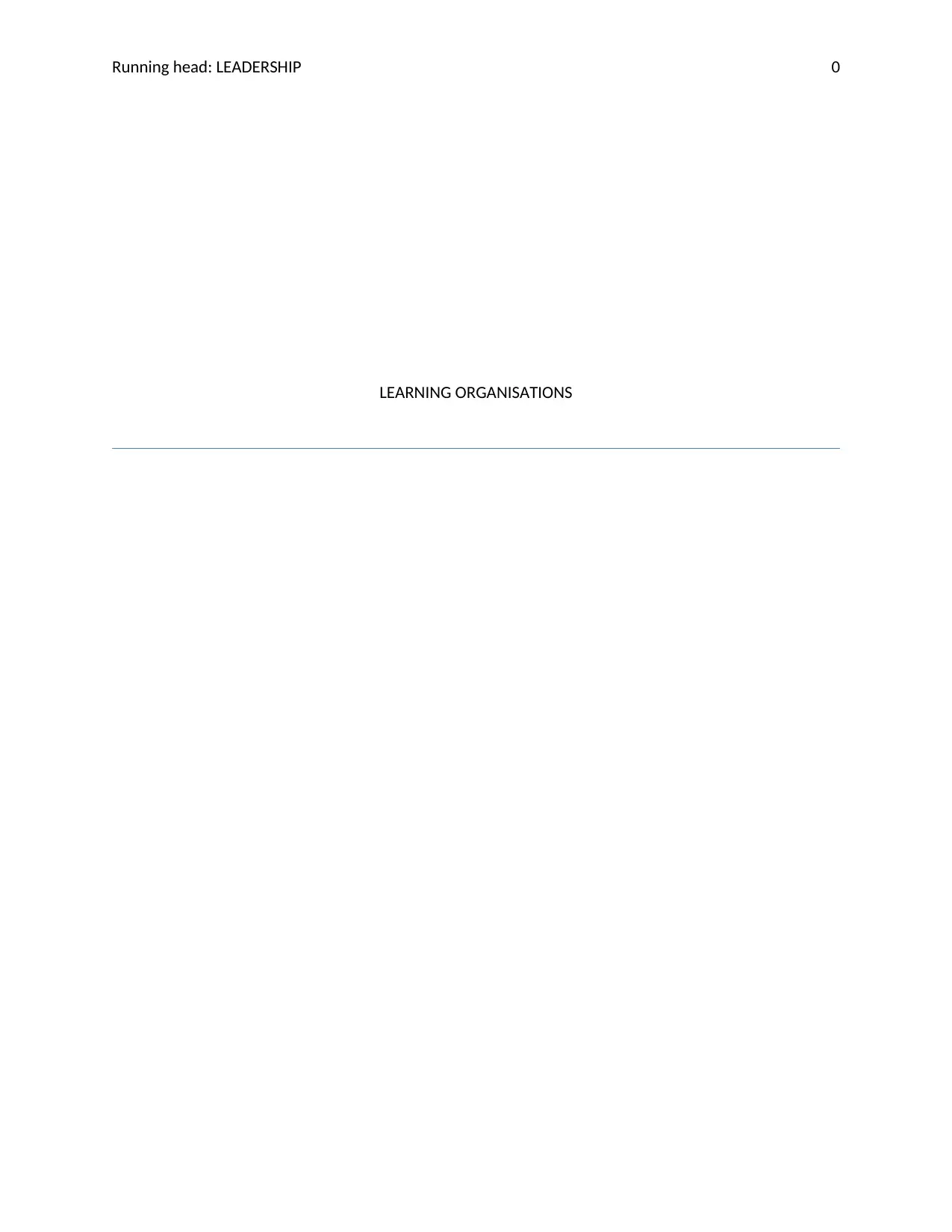
Running head: LEADERSHIP 0
LEARNING ORGANISATIONS
LEARNING ORGANISATIONS
Paraphrase This Document
Need a fresh take? Get an instant paraphrase of this document with our AI Paraphraser
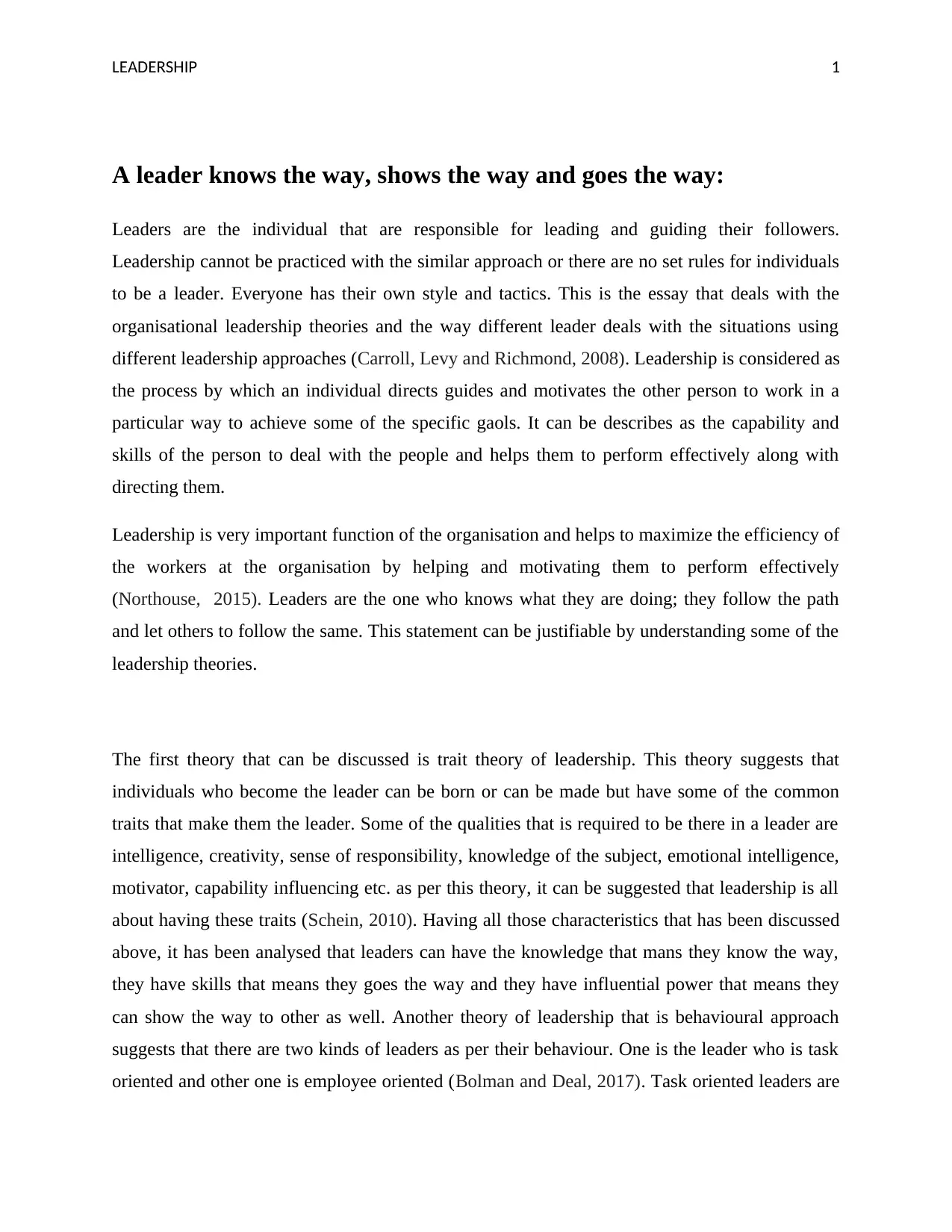
LEADERSHIP 1
A leader knows the way, shows the way and goes the way:
Leaders are the individual that are responsible for leading and guiding their followers.
Leadership cannot be practiced with the similar approach or there are no set rules for individuals
to be a leader. Everyone has their own style and tactics. This is the essay that deals with the
organisational leadership theories and the way different leader deals with the situations using
different leadership approaches (Carroll, Levy and Richmond, 2008). Leadership is considered as
the process by which an individual directs guides and motivates the other person to work in a
particular way to achieve some of the specific gaols. It can be describes as the capability and
skills of the person to deal with the people and helps them to perform effectively along with
directing them.
Leadership is very important function of the organisation and helps to maximize the efficiency of
the workers at the organisation by helping and motivating them to perform effectively
(Northouse, 2015). Leaders are the one who knows what they are doing; they follow the path
and let others to follow the same. This statement can be justifiable by understanding some of the
leadership theories.
The first theory that can be discussed is trait theory of leadership. This theory suggests that
individuals who become the leader can be born or can be made but have some of the common
traits that make them the leader. Some of the qualities that is required to be there in a leader are
intelligence, creativity, sense of responsibility, knowledge of the subject, emotional intelligence,
motivator, capability influencing etc. as per this theory, it can be suggested that leadership is all
about having these traits (Schein, 2010). Having all those characteristics that has been discussed
above, it has been analysed that leaders can have the knowledge that mans they know the way,
they have skills that means they goes the way and they have influential power that means they
can show the way to other as well. Another theory of leadership that is behavioural approach
suggests that there are two kinds of leaders as per their behaviour. One is the leader who is task
oriented and other one is employee oriented (Bolman and Deal, 2017). Task oriented leaders are
A leader knows the way, shows the way and goes the way:
Leaders are the individual that are responsible for leading and guiding their followers.
Leadership cannot be practiced with the similar approach or there are no set rules for individuals
to be a leader. Everyone has their own style and tactics. This is the essay that deals with the
organisational leadership theories and the way different leader deals with the situations using
different leadership approaches (Carroll, Levy and Richmond, 2008). Leadership is considered as
the process by which an individual directs guides and motivates the other person to work in a
particular way to achieve some of the specific gaols. It can be describes as the capability and
skills of the person to deal with the people and helps them to perform effectively along with
directing them.
Leadership is very important function of the organisation and helps to maximize the efficiency of
the workers at the organisation by helping and motivating them to perform effectively
(Northouse, 2015). Leaders are the one who knows what they are doing; they follow the path
and let others to follow the same. This statement can be justifiable by understanding some of the
leadership theories.
The first theory that can be discussed is trait theory of leadership. This theory suggests that
individuals who become the leader can be born or can be made but have some of the common
traits that make them the leader. Some of the qualities that is required to be there in a leader are
intelligence, creativity, sense of responsibility, knowledge of the subject, emotional intelligence,
motivator, capability influencing etc. as per this theory, it can be suggested that leadership is all
about having these traits (Schein, 2010). Having all those characteristics that has been discussed
above, it has been analysed that leaders can have the knowledge that mans they know the way,
they have skills that means they goes the way and they have influential power that means they
can show the way to other as well. Another theory of leadership that is behavioural approach
suggests that there are two kinds of leaders as per their behaviour. One is the leader who is task
oriented and other one is employee oriented (Bolman and Deal, 2017). Task oriented leaders are
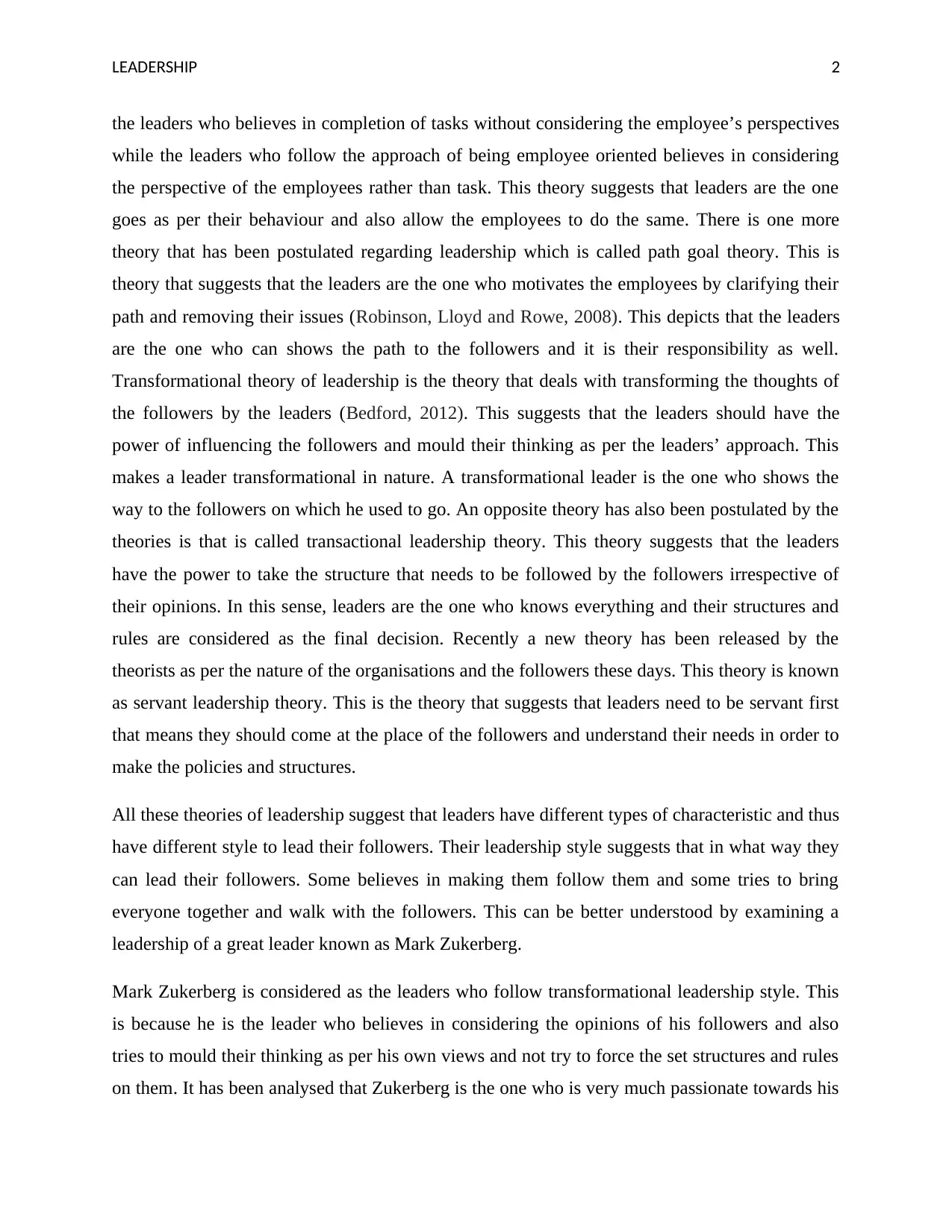
LEADERSHIP 2
the leaders who believes in completion of tasks without considering the employee’s perspectives
while the leaders who follow the approach of being employee oriented believes in considering
the perspective of the employees rather than task. This theory suggests that leaders are the one
goes as per their behaviour and also allow the employees to do the same. There is one more
theory that has been postulated regarding leadership which is called path goal theory. This is
theory that suggests that the leaders are the one who motivates the employees by clarifying their
path and removing their issues (Robinson, Lloyd and Rowe, 2008). This depicts that the leaders
are the one who can shows the path to the followers and it is their responsibility as well.
Transformational theory of leadership is the theory that deals with transforming the thoughts of
the followers by the leaders (Bedford, 2012). This suggests that the leaders should have the
power of influencing the followers and mould their thinking as per the leaders’ approach. This
makes a leader transformational in nature. A transformational leader is the one who shows the
way to the followers on which he used to go. An opposite theory has also been postulated by the
theories is that is called transactional leadership theory. This theory suggests that the leaders
have the power to take the structure that needs to be followed by the followers irrespective of
their opinions. In this sense, leaders are the one who knows everything and their structures and
rules are considered as the final decision. Recently a new theory has been released by the
theorists as per the nature of the organisations and the followers these days. This theory is known
as servant leadership theory. This is the theory that suggests that leaders need to be servant first
that means they should come at the place of the followers and understand their needs in order to
make the policies and structures.
All these theories of leadership suggest that leaders have different types of characteristic and thus
have different style to lead their followers. Their leadership style suggests that in what way they
can lead their followers. Some believes in making them follow them and some tries to bring
everyone together and walk with the followers. This can be better understood by examining a
leadership of a great leader known as Mark Zukerberg.
Mark Zukerberg is considered as the leaders who follow transformational leadership style. This
is because he is the leader who believes in considering the opinions of his followers and also
tries to mould their thinking as per his own views and not try to force the set structures and rules
on them. It has been analysed that Zukerberg is the one who is very much passionate towards his
the leaders who believes in completion of tasks without considering the employee’s perspectives
while the leaders who follow the approach of being employee oriented believes in considering
the perspective of the employees rather than task. This theory suggests that leaders are the one
goes as per their behaviour and also allow the employees to do the same. There is one more
theory that has been postulated regarding leadership which is called path goal theory. This is
theory that suggests that the leaders are the one who motivates the employees by clarifying their
path and removing their issues (Robinson, Lloyd and Rowe, 2008). This depicts that the leaders
are the one who can shows the path to the followers and it is their responsibility as well.
Transformational theory of leadership is the theory that deals with transforming the thoughts of
the followers by the leaders (Bedford, 2012). This suggests that the leaders should have the
power of influencing the followers and mould their thinking as per the leaders’ approach. This
makes a leader transformational in nature. A transformational leader is the one who shows the
way to the followers on which he used to go. An opposite theory has also been postulated by the
theories is that is called transactional leadership theory. This theory suggests that the leaders
have the power to take the structure that needs to be followed by the followers irrespective of
their opinions. In this sense, leaders are the one who knows everything and their structures and
rules are considered as the final decision. Recently a new theory has been released by the
theorists as per the nature of the organisations and the followers these days. This theory is known
as servant leadership theory. This is the theory that suggests that leaders need to be servant first
that means they should come at the place of the followers and understand their needs in order to
make the policies and structures.
All these theories of leadership suggest that leaders have different types of characteristic and thus
have different style to lead their followers. Their leadership style suggests that in what way they
can lead their followers. Some believes in making them follow them and some tries to bring
everyone together and walk with the followers. This can be better understood by examining a
leadership of a great leader known as Mark Zukerberg.
Mark Zukerberg is considered as the leaders who follow transformational leadership style. This
is because he is the leader who believes in considering the opinions of his followers and also
tries to mould their thinking as per his own views and not try to force the set structures and rules
on them. It has been analysed that Zukerberg is the one who is very much passionate towards his
⊘ This is a preview!⊘
Do you want full access?
Subscribe today to unlock all pages.

Trusted by 1+ million students worldwide
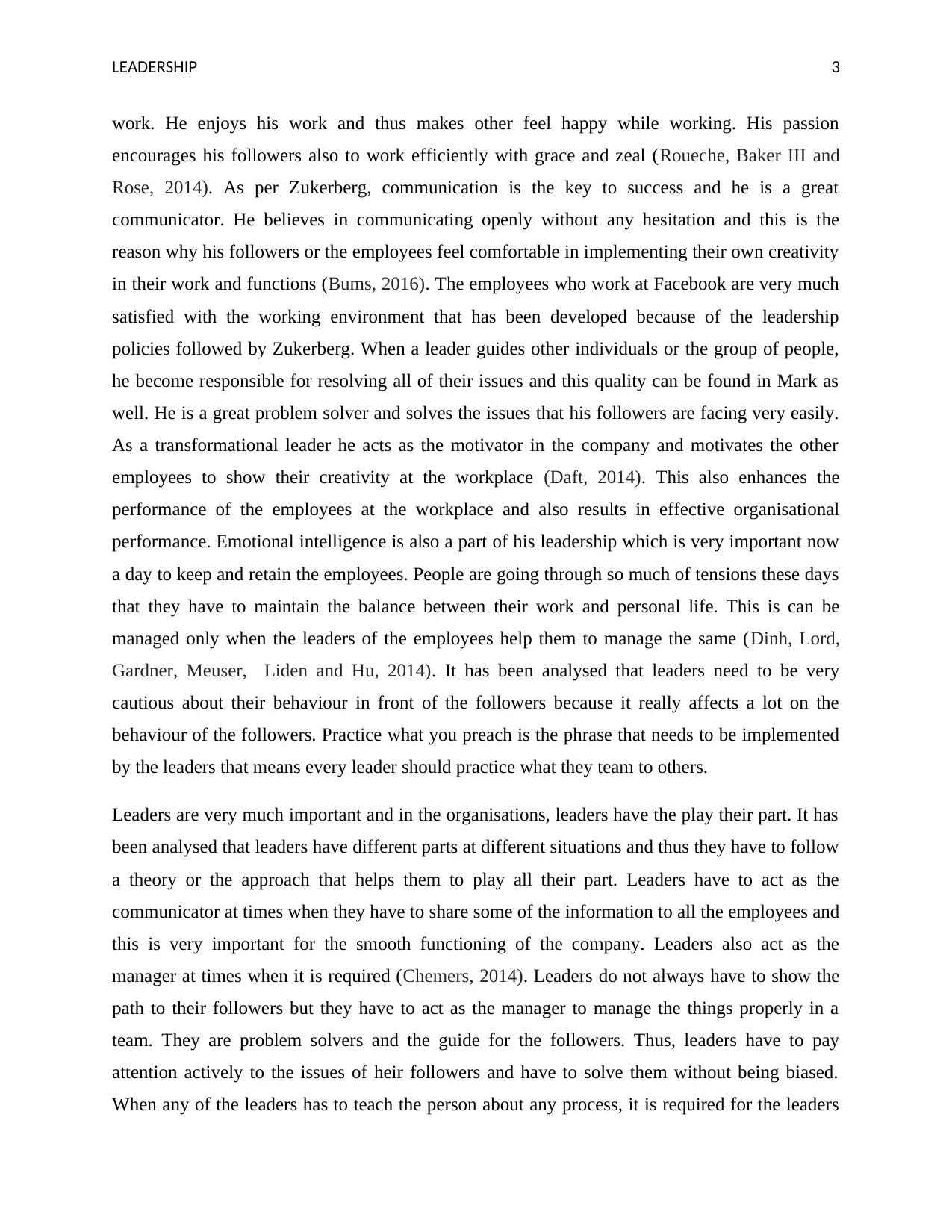
LEADERSHIP 3
work. He enjoys his work and thus makes other feel happy while working. His passion
encourages his followers also to work efficiently with grace and zeal (Roueche, Baker III and
Rose, 2014). As per Zukerberg, communication is the key to success and he is a great
communicator. He believes in communicating openly without any hesitation and this is the
reason why his followers or the employees feel comfortable in implementing their own creativity
in their work and functions (Bums, 2016). The employees who work at Facebook are very much
satisfied with the working environment that has been developed because of the leadership
policies followed by Zukerberg. When a leader guides other individuals or the group of people,
he become responsible for resolving all of their issues and this quality can be found in Mark as
well. He is a great problem solver and solves the issues that his followers are facing very easily.
As a transformational leader he acts as the motivator in the company and motivates the other
employees to show their creativity at the workplace (Daft, 2014). This also enhances the
performance of the employees at the workplace and also results in effective organisational
performance. Emotional intelligence is also a part of his leadership which is very important now
a day to keep and retain the employees. People are going through so much of tensions these days
that they have to maintain the balance between their work and personal life. This is can be
managed only when the leaders of the employees help them to manage the same (Dinh, Lord,
Gardner, Meuser, Liden and Hu, 2014). It has been analysed that leaders need to be very
cautious about their behaviour in front of the followers because it really affects a lot on the
behaviour of the followers. Practice what you preach is the phrase that needs to be implemented
by the leaders that means every leader should practice what they team to others.
Leaders are very much important and in the organisations, leaders have the play their part. It has
been analysed that leaders have different parts at different situations and thus they have to follow
a theory or the approach that helps them to play all their part. Leaders have to act as the
communicator at times when they have to share some of the information to all the employees and
this is very important for the smooth functioning of the company. Leaders also act as the
manager at times when it is required (Chemers, 2014). Leaders do not always have to show the
path to their followers but they have to act as the manager to manage the things properly in a
team. They are problem solvers and the guide for the followers. Thus, leaders have to pay
attention actively to the issues of heir followers and have to solve them without being biased.
When any of the leaders has to teach the person about any process, it is required for the leaders
work. He enjoys his work and thus makes other feel happy while working. His passion
encourages his followers also to work efficiently with grace and zeal (Roueche, Baker III and
Rose, 2014). As per Zukerberg, communication is the key to success and he is a great
communicator. He believes in communicating openly without any hesitation and this is the
reason why his followers or the employees feel comfortable in implementing their own creativity
in their work and functions (Bums, 2016). The employees who work at Facebook are very much
satisfied with the working environment that has been developed because of the leadership
policies followed by Zukerberg. When a leader guides other individuals or the group of people,
he become responsible for resolving all of their issues and this quality can be found in Mark as
well. He is a great problem solver and solves the issues that his followers are facing very easily.
As a transformational leader he acts as the motivator in the company and motivates the other
employees to show their creativity at the workplace (Daft, 2014). This also enhances the
performance of the employees at the workplace and also results in effective organisational
performance. Emotional intelligence is also a part of his leadership which is very important now
a day to keep and retain the employees. People are going through so much of tensions these days
that they have to maintain the balance between their work and personal life. This is can be
managed only when the leaders of the employees help them to manage the same (Dinh, Lord,
Gardner, Meuser, Liden and Hu, 2014). It has been analysed that leaders need to be very
cautious about their behaviour in front of the followers because it really affects a lot on the
behaviour of the followers. Practice what you preach is the phrase that needs to be implemented
by the leaders that means every leader should practice what they team to others.
Leaders are very much important and in the organisations, leaders have the play their part. It has
been analysed that leaders have different parts at different situations and thus they have to follow
a theory or the approach that helps them to play all their part. Leaders have to act as the
communicator at times when they have to share some of the information to all the employees and
this is very important for the smooth functioning of the company. Leaders also act as the
manager at times when it is required (Chemers, 2014). Leaders do not always have to show the
path to their followers but they have to act as the manager to manage the things properly in a
team. They are problem solvers and the guide for the followers. Thus, leaders have to pay
attention actively to the issues of heir followers and have to solve them without being biased.
When any of the leaders has to teach the person about any process, it is required for the leaders
Paraphrase This Document
Need a fresh take? Get an instant paraphrase of this document with our AI Paraphraser
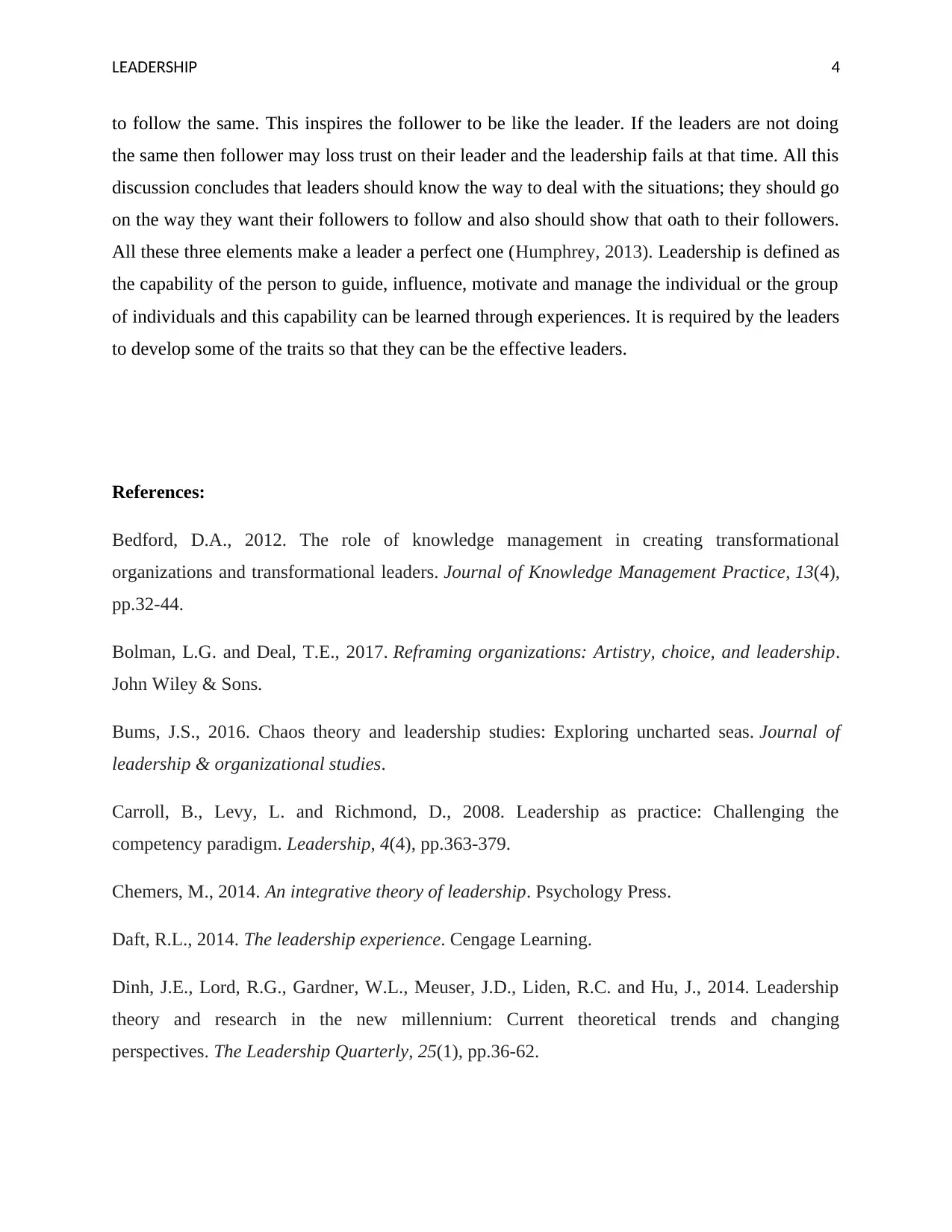
LEADERSHIP 4
to follow the same. This inspires the follower to be like the leader. If the leaders are not doing
the same then follower may loss trust on their leader and the leadership fails at that time. All this
discussion concludes that leaders should know the way to deal with the situations; they should go
on the way they want their followers to follow and also should show that oath to their followers.
All these three elements make a leader a perfect one (Humphrey, 2013). Leadership is defined as
the capability of the person to guide, influence, motivate and manage the individual or the group
of individuals and this capability can be learned through experiences. It is required by the leaders
to develop some of the traits so that they can be the effective leaders.
References:
Bedford, D.A., 2012. The role of knowledge management in creating transformational
organizations and transformational leaders. Journal of Knowledge Management Practice, 13(4),
pp.32-44.
Bolman, L.G. and Deal, T.E., 2017. Reframing organizations: Artistry, choice, and leadership.
John Wiley & Sons.
Bums, J.S., 2016. Chaos theory and leadership studies: Exploring uncharted seas. Journal of
leadership & organizational studies.
Carroll, B., Levy, L. and Richmond, D., 2008. Leadership as practice: Challenging the
competency paradigm. Leadership, 4(4), pp.363-379.
Chemers, M., 2014. An integrative theory of leadership. Psychology Press.
Daft, R.L., 2014. The leadership experience. Cengage Learning.
Dinh, J.E., Lord, R.G., Gardner, W.L., Meuser, J.D., Liden, R.C. and Hu, J., 2014. Leadership
theory and research in the new millennium: Current theoretical trends and changing
perspectives. The Leadership Quarterly, 25(1), pp.36-62.
to follow the same. This inspires the follower to be like the leader. If the leaders are not doing
the same then follower may loss trust on their leader and the leadership fails at that time. All this
discussion concludes that leaders should know the way to deal with the situations; they should go
on the way they want their followers to follow and also should show that oath to their followers.
All these three elements make a leader a perfect one (Humphrey, 2013). Leadership is defined as
the capability of the person to guide, influence, motivate and manage the individual or the group
of individuals and this capability can be learned through experiences. It is required by the leaders
to develop some of the traits so that they can be the effective leaders.
References:
Bedford, D.A., 2012. The role of knowledge management in creating transformational
organizations and transformational leaders. Journal of Knowledge Management Practice, 13(4),
pp.32-44.
Bolman, L.G. and Deal, T.E., 2017. Reframing organizations: Artistry, choice, and leadership.
John Wiley & Sons.
Bums, J.S., 2016. Chaos theory and leadership studies: Exploring uncharted seas. Journal of
leadership & organizational studies.
Carroll, B., Levy, L. and Richmond, D., 2008. Leadership as practice: Challenging the
competency paradigm. Leadership, 4(4), pp.363-379.
Chemers, M., 2014. An integrative theory of leadership. Psychology Press.
Daft, R.L., 2014. The leadership experience. Cengage Learning.
Dinh, J.E., Lord, R.G., Gardner, W.L., Meuser, J.D., Liden, R.C. and Hu, J., 2014. Leadership
theory and research in the new millennium: Current theoretical trends and changing
perspectives. The Leadership Quarterly, 25(1), pp.36-62.
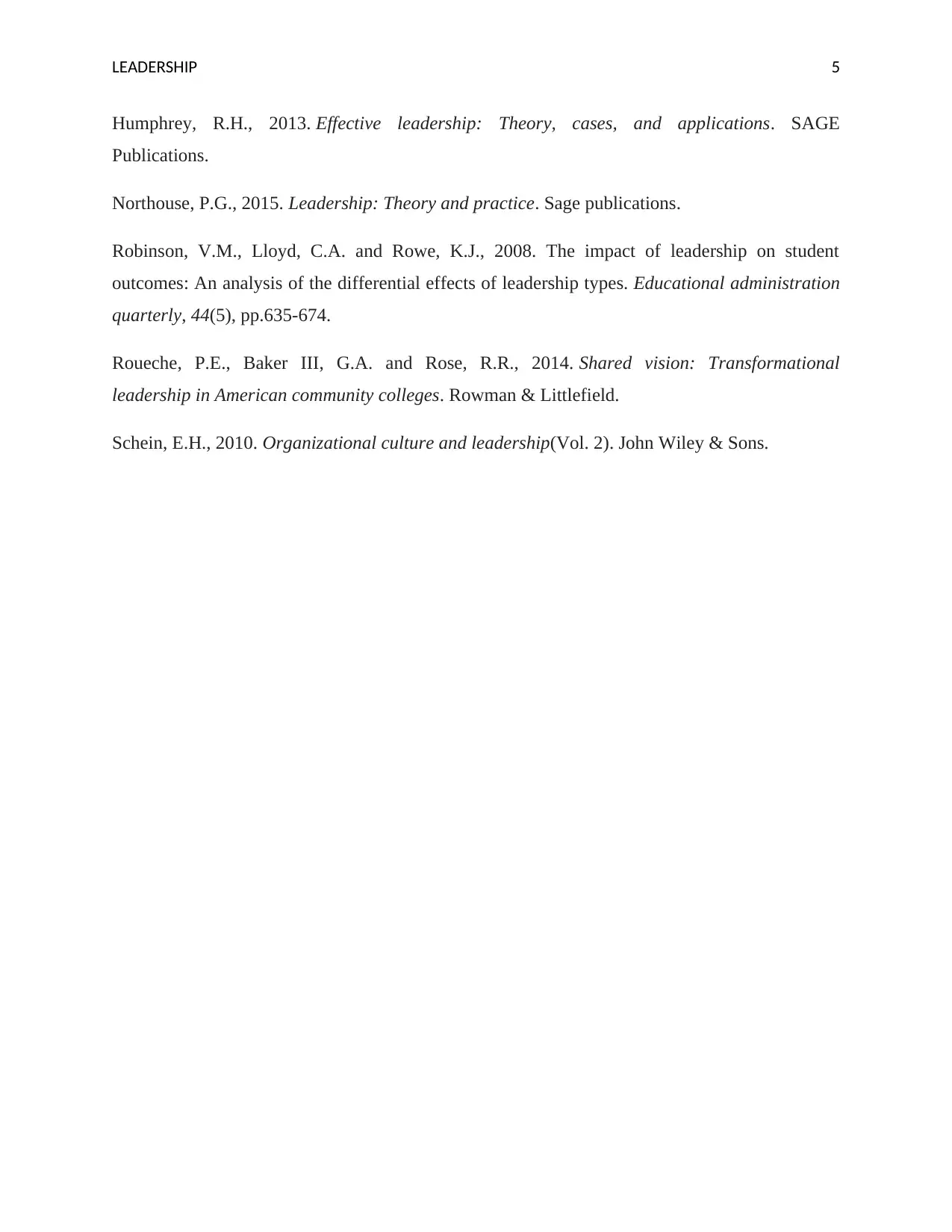
LEADERSHIP 5
Humphrey, R.H., 2013. Effective leadership: Theory, cases, and applications. SAGE
Publications.
Northouse, P.G., 2015. Leadership: Theory and practice. Sage publications.
Robinson, V.M., Lloyd, C.A. and Rowe, K.J., 2008. The impact of leadership on student
outcomes: An analysis of the differential effects of leadership types. Educational administration
quarterly, 44(5), pp.635-674.
Roueche, P.E., Baker III, G.A. and Rose, R.R., 2014. Shared vision: Transformational
leadership in American community colleges. Rowman & Littlefield.
Schein, E.H., 2010. Organizational culture and leadership(Vol. 2). John Wiley & Sons.
Humphrey, R.H., 2013. Effective leadership: Theory, cases, and applications. SAGE
Publications.
Northouse, P.G., 2015. Leadership: Theory and practice. Sage publications.
Robinson, V.M., Lloyd, C.A. and Rowe, K.J., 2008. The impact of leadership on student
outcomes: An analysis of the differential effects of leadership types. Educational administration
quarterly, 44(5), pp.635-674.
Roueche, P.E., Baker III, G.A. and Rose, R.R., 2014. Shared vision: Transformational
leadership in American community colleges. Rowman & Littlefield.
Schein, E.H., 2010. Organizational culture and leadership(Vol. 2). John Wiley & Sons.
⊘ This is a preview!⊘
Do you want full access?
Subscribe today to unlock all pages.

Trusted by 1+ million students worldwide
1 out of 6
Related Documents
Your All-in-One AI-Powered Toolkit for Academic Success.
+13062052269
info@desklib.com
Available 24*7 on WhatsApp / Email
![[object Object]](/_next/static/media/star-bottom.7253800d.svg)
Unlock your academic potential
Copyright © 2020–2025 A2Z Services. All Rights Reserved. Developed and managed by ZUCOL.





